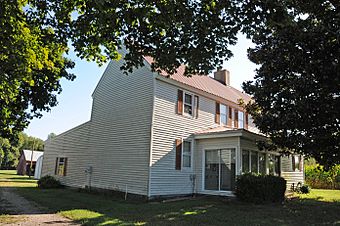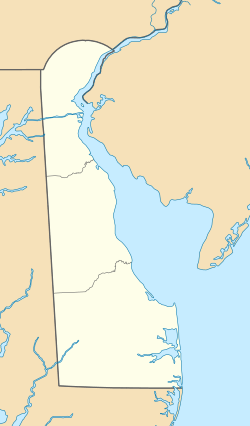Cheney Clow facts for kids
Quick facts for kids |
|
|
Scene of Cheyney Clow's Rebellion
|
|
 |
|
| Location | West of Kenton on Delaware Route 300, near Kenton, Delaware |
|---|---|
| Area | 160 acres (65 ha) |
| NRHP reference No. | 74000598 |
| Added to NRHP | January 14, 1974 |
Cheney Clow (1734–1788) was a person from Delaware Colony during the American Revolution. He was a Loyalist, meaning he supported the King of Britain. He led a small uprising against the local government that wanted to break away from British rule. This event is known as Clow's Rebellion.
Contents
Who Was Cheney Clow?
Early Life and Family
Cheney Clow was born in 1734 in the Delaware Colony. He was the third of nine children. His parents, Nathaniel and Susannah Clow, owned a farm in Queen Anne's County, Province of Maryland. Their land included areas called "Clow's Hope" and "Boon's Hope." In those days, people sometimes paid for land with tobacco from their farms.
Cheney's father, Nathaniel, passed away in 1748. He wanted his farm and belongings to be shared equally among his wife and children. His children were John, Mary, Cheney, Susannah, Rachael, James, Sarah, Rebecca, and Ann. Cheney's mother, Susannah, died sometime before 1756.
Marriage and Children
Cheney Clow married Elizabeth Barcus (also known as Barkhurst). They lived and farmed in the same area as Cheney's parents. They had at least two children, Joshua and Arrana.
Cheney's Rebellion: A Local Uprising
Choosing Sides in the Revolution
When the American War of Independence began, not everyone wanted to be independent from Britain. In Kent County, Delaware, where Cheney Clow lived, most people supported independence. However, Cheney Clow chose to support the British King. He became a Tory, which was another name for Loyalists.
As the war continued, some Loyalists caused trouble by raiding farms and stealing supplies. They became very unpopular with their neighbors.
Refusing to Take an Oath
In 1778, the Delaware colony passed a law. It said that all men over 21 had to take an "Oath of Allegiance." This oath meant they promised to be loyal to the new American government. If a Loyalist took the oath, they would be forgiven for their past actions. If they refused, their land and belongings could be taken away.
Cheney Clow refused to take this oath. He also refused to pay taxes to Delaware. He claimed he lived in Maryland, even though his house was in Delaware, right near the state line.
The Confrontation and Arrest
On April 18, 1778, the Sheriff of Kent County, John Clayton, went to arrest Cheney Clow. This attempt led to a gunfight. During the struggle, one of the sheriff's men was killed. Cheney's wife, Susannah, who was helping him load rifles, was also wounded. Cheney was then arrested and taken to jail. This event became known as "Cheney Clow's Rebellion."
After his arrest, Cheney Clow remained in prison for four years. He faced various legal challenges for his actions. He was eventually put to death in 1788 for his role in the rebellion. After his death, public opinion changed, and many people felt he had been treated unfairly because of his political beliefs.
The Site of the Rebellion
Where the Conflict Happened
The place where Cheney Clow's Rebellion happened is on two farms near the Maryland border in Kent County, Delaware. These farms also extend into Maryland. One of the farms has the Clark House, an old building that might have been there during the Revolution.
Near the Clark House, a stream called Gravelly Branch separates the farms. Historical records from 1829 mention a "Cheyney Clow's fort" nearby. This fort was likely in a swampy area where two parts of Gravelly Branch meet. Even though the fort was supposedly burned by the militia, some logs were still visible decades later.
Why the Site is Important
The site of Cheney Clow's Fort and the surrounding fields were the location of Kent County, Delaware's only battle during the American Revolution. Even though the fort is gone, the farms where the battle took place are still used today. The area looks much like it did during the Revolution.
Cheney Clow was a unique local figure who gathered a small group of Loyalists. He led them in raids on farms in the area. The local people asked for military help to stop him. A militia leader named Charles Pope was sent to deal with the rebellion. He reported that Clow had built a fort. The militia tried to attack but Clow escaped, and the militia burned the fort.
Cheney Clow's story highlights the mixed feelings about the Revolution in Kent County, Delaware.
Cheney Clow's Legacy
Family and Descendants
After Cheney Clow's death, most of his children stayed in the Northern Queen Anne's County, Maryland and Kent County, Delaware areas. They raised families, and their descendants live there to this day. One of his sons, Joshua, moved west to the Ohio Valley and changed the spelling of the family name to Clough.
Many of Cheney Clow's direct descendants still live in and around the area where he lived and had his rebellion, especially near Sudlersville, Maryland. The family name is now spelled both Clow and Clough.
Continuing Influence
Cheney Clow's life and actions continue to be a part of the history and local stories in Kent County, Delaware and Northern Queen Anne's County, Maryland. His story reminds people of the complex loyalties and challenges faced during the American Revolution.
Images for kids




